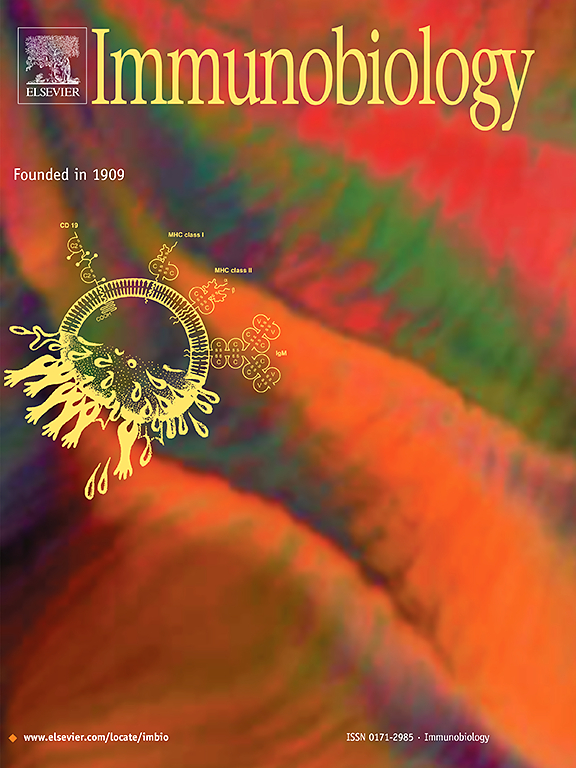Preclinical models of immune checkpoint inhibitors-related interstitial pneumonia for anti-PD1 tumor immunotherapy
IF 2.3
4区 医学
Q3 IMMUNOLOGY
引用次数: 0
Abstract
Immune-related adverse reactions (irAEs) are common adverse reactions after immune checkpoint inhibitor treatment, impacting the universality and continued use of immunotherapy. Currently, preclinical models to investigate the mechanisms underlying these adverse effects are inadequate. This study aims to develop both in vitro and in vivo models of irAEs to advance basic research on these adverse reactions. For vitro models, we designed two co-culture systems: “Lung epithelial cells-PBMC” conditional co-culture model and “organoid-PBMCs” co-culture model. These involve culturing spheroids, patient-derived organoids and isolating, expanding, and co-culturing peripheral blood mononuclear cells (PBMCs). For vivo model, PD1 humanized mice were used to establish a lung carcinoma in situ model in offspring, with blocked immune checkpoints to induce systemic inflammatory responses. Mice without PD-1 blockade served as the control group. In both organoid and “lung epithelial cell-PBMC” models, compared with the control group, the PBMC+anti-PD1 group exhibited inflammatory injury, demonstrated by the worst activity, increased collagen deposition, elevated mRNA levels of αSMA and Vimentin, higher Fibronectin expression, and higher inflammatory factors (IL6, IL1β, MPO) in the culture supernatant (p < 0.05). In vivo model also showed pulmonary inflammation, with slower weight gain of the affected mice, more obvious pulmonary interstitial thickening(Masson staining and α-SMA immunofluorescence staining), and increased immune cells and IL17A in alveolar lavage fluid and serum. This study successfully developed preclinical models of irAEs using organoid technology, conditioned co-culture and humanized mouse models, effectively reproducing inflammatory injury and offering valuable tools for irAE research.
免疫检查点抑制剂相关间质性肺炎抗pd1肿瘤免疫治疗的临床前模型
免疫相关不良反应(irAEs)是免疫检查点抑制剂治疗后常见的不良反应,影响着免疫治疗的普适性和持续使用。目前,临床前模型不足以研究这些不良反应的机制。本研究旨在建立irAEs体外和体内模型,以推进这些不良反应的基础研究。对于体外模型,我们设计了两种共培养系统:“肺上皮细胞- pbmc”条件共培养模型和“类器官- pbmc”共培养模型。这些包括培养球形细胞、患者来源的类器官和分离、扩增和共培养外周血单核细胞(PBMCs)。体内模型采用PD1人源化小鼠建立子代原位肺癌模型,阻断免疫检查点诱导全身炎症反应。未阻断PD-1的小鼠作为对照组。在类器官和“肺上皮细胞-PBMC”模型中,与对照组相比,PBMC+抗pd1组均表现出炎症损伤,表现为活性最差,胶原沉积增加,αSMA和Vimentin mRNA水平升高,纤维连接蛋白表达升高,培养上清中炎症因子(IL6、IL1β、MPO)水平升高(p <;0.05)。体内模型也出现肺部炎症,小鼠增重较慢,肺间质增厚较明显(Masson染色和α-SMA免疫荧光染色),肺泡灌洗液和血清中免疫细胞和IL17A升高。本研究利用类器官技术、条件共培养和人源化小鼠模型成功构建了irAE临床前模型,有效地再现了炎症损伤,为irAE研究提供了有价值的工具。
本文章由计算机程序翻译,如有差异,请以英文原文为准。
求助全文
约1分钟内获得全文
求助全文
来源期刊

Immunobiology
医学-免疫学
CiteScore
5.00
自引率
3.60%
发文量
108
审稿时长
55 days
期刊介绍:
Immunobiology is a peer-reviewed journal that publishes highly innovative research approaches for a wide range of immunological subjects, including
• Innate Immunity,
• Adaptive Immunity,
• Complement Biology,
• Macrophage and Dendritic Cell Biology,
• Parasite Immunology,
• Tumour Immunology,
• Clinical Immunology,
• Immunogenetics,
• Immunotherapy and
• Immunopathology of infectious, allergic and autoimmune disease.
 求助内容:
求助内容: 应助结果提醒方式:
应助结果提醒方式:


